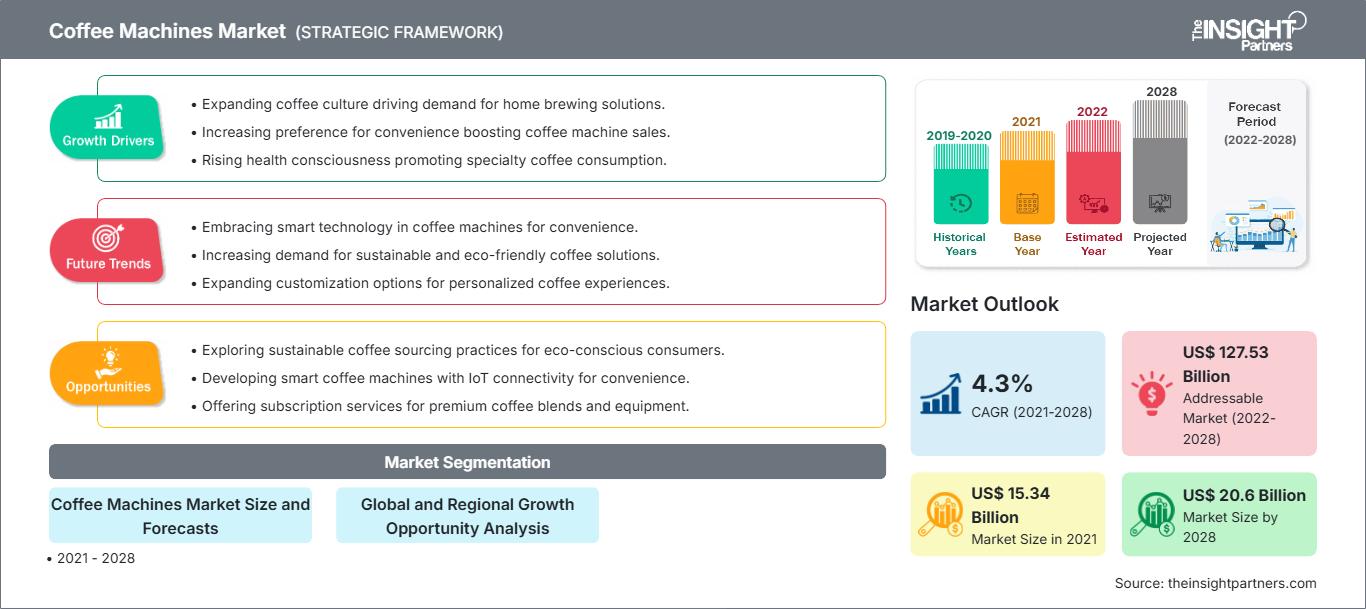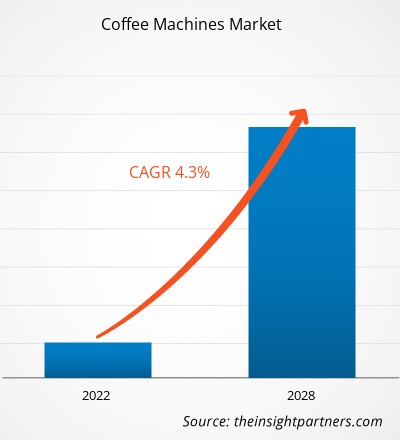[Forschungsbericht] Der Markt für Kaffeemaschinen hatte im Jahr 2021 ein Volumen von 15.340,75 Millionen US-Dollar und soll bis 2028 20.596,79 Millionen US-Dollar erreichen; von 2021 bis 2028 wird ein CAGR-Wachstum von 4,3 % erwartet.
Markteinblicke und Analystenmeinung:
Eine Kaffeemaschine ist ein Gerät zum Zubereiten von Kaffee. Es gibt verschiedene Arten von Kaffeemaschinen, wie z. B. French Press, Espressomaschinen, Filterkaffeemaschinen, Kapsel- und Pad-Kaffeemaschinen und mehr. Jede Maschine funktioniert nach einem anderen Mechanismus. Bei einer Filterkaffeemaschine beispielsweise tropft Wasser automatisch in ein Heizrohr und wird auf gemahlenen Kaffee gegossen, der durch einen Filter läuft. Bei einer Kapsel- und Pad-Kaffeemaschine hingegen wird der Kaffee in eine Kapsel aus Kunststoff oder Aluminium gefüllt und in einem kleinen Behälter aufbewahrt, der in die Kaffeemaschine eingesetzt wird, und der Kaffee wird gebrüht. Sowohl im Unternehmens- als auch im institutionellen Sektor besteht eine steigende Nachfrage nach Kaffeemaschinen. Dieser Faktor treibt den weltweiten Kaffeemaschinenmarkt maßgeblich an.
Wachstumstreiber und Herausforderungen:
In den letzten Jahren hat sich der Lebensstil der Menschen aufgrund hektischer Arbeitspläne und langer Arbeitszeiten dramatisch verändert. Aufgrund des schnelllebigen Lebensstils greifen die Menschen zunehmend zu Fertiggerichten und -getränken. Im Unternehmenssektor sind die Menschen ständig arbeitsbedingtem Stress ausgesetzt und suchen daher nach Freizeit, die sie mit Kollegen und Freunden verbringen können. Kaffee ist eines der vielseitigsten Getränke, das aufgrund seines verwöhnenden Geschmacks und Aromas weit verbreitet ist. Darüber hinaus hilft sein Koffeingehalt, die Stimmung zu heben und die Motivation zu steigern. Dieser Faktor treibt die Kaffeeindustrie weltweit maßgeblich an. Kaffeemaschinen ermöglichen die sofortige Zubereitung von Kaffee, weshalb im Unternehmenssektor eine hohe Nachfrage nach Kaffeemaschinen besteht. Dieser Faktor treibt den Kaffeemaschinenmarkt maßgeblich an. Da sich die Menschen jedoch zunehmend der Suchtgefahr von Kaffee bewusst sind, ersetzen sie diesen durch andere Getränke wie Fruchtsäfte, Bubble Tea, Mineralwasser usw. Auch das zunehmende Bewusstsein für die negativen gesundheitlichen Auswirkungen eines hohen Koffeinkonsums bremst die Kaffeenachfrage. Diese Faktoren werden sich voraussichtlich negativ auf den Kaffeekonsum auswirken und die Nachfrage nach Kaffeemaschinen im Prognosezeitraum verringern.
Passen Sie diesen Bericht Ihren Anforderungen an
Sie erhalten kostenlos Anpassungen an jedem Bericht, einschließlich Teilen dieses Berichts oder einer Analyse auf Länderebene, eines Excel-Datenpakets sowie tolle Angebote und Rabatte für Start-ups und Universitäten.
Markt für Kaffeemaschinen: Strategische Einblicke

-
Holen Sie sich die wichtigsten Markttrends aus diesem Bericht.Dieses KOSTENLOSE Beispiel umfasst Datenanalysen, die von Markttrends bis hin zu Schätzungen und Prognosen reichen.
Berichtssegmentierung und -umfang
Der „globale Markt für Kaffeemaschinen“ ist nach Typ, Kategorie, Endbenutzer und Geografie segmentiert. Nach dem Typ ist der Markt für Kaffeemaschinen in Filterkaffeemaschinen, Espressomaschinen, Kapsel- und Padkaffeemaschinen und Sonstige unterteilt. Nach der Kategorie ist der Markt in manuell, automatisch und halbautomatisch eingeteilt. Nach dem Endbenutzer ist der Markt für Kaffeemaschinen in Privathaushalte und Nicht-Privathaushalte segmentiert. Nach der Geografie ist der Markt für Kaffeemaschinen in Nordamerika (USA, Kanada und Mexiko), Europa (Deutschland, Frankreich, Italien, Großbritannien, Russland und übriges Europa), Asien-Pazifik (Australien, China, Japan, Indien, Südkorea und übriger Asien-Pazifik-Raum), Naher Osten und Afrika (Südafrika, Saudi-Arabien, Vereinigte Arabische Emirate und übriger Naher Osten und Afrika) und Süd- und Südamerika unterteilt. Mittelamerika (Brasilien, Argentinien und übriges Süd- und Mittelamerika)
Segmentanalyse:
Basierend auf dem Endverbraucher ist der Markt für Kaffeemaschinen in private und gewerbliche Nutzer unterteilt. Das Segment für private Nutzer hatte den größten Anteil am Markt für Kaffeemaschinen und wird im Prognosezeitraum voraussichtlich ein deutliches Wachstum verzeichnen. Die zunehmende Akzeptanz von Kaffee und das wachsende Interesse an verschiedenen Röst- und Brühsorten treiben die Nachfrage nach Kaffeemaschinen im gesamten privaten Sektor an. Aufgrund des Ausbruchs von COVID-19 mussten die Menschen außerdem zu Hause bleiben und alle Gastronomiebetriebe blieben geschlossen. Dies löste in allen Haushalten, insbesondere in den Industrieländern, eine steigende Nachfrage nach Kaffeemaschinen aus. All diese Faktoren beflügeln potenziell den weltweiten Markt für Kaffeemaschinen.
Regionale Analyse:
Geografisch ist der Markt für Kaffeemaschinen in fünf Schlüsselregionen unterteilt: Nordamerika, Europa, Asien-Pazifik, Süd- und Mittelamerika sowie Naher Osten und Afrika. Der globale Markt für Kaffeemaschinen wurde von Europa dominiert, das im Jahr 2022 4.951,77 Millionen US-Dollar ausmachte. Nordamerika ist ein zweitgrößter Marktteilnehmer mit einem Anteil von über 20 % am Weltmarkt. Für den asiatisch-pazifischen Raum wird im Prognosezeitraum ein beträchtliches Wachstum mit einer durchschnittlichen jährlichen Wachstumsrate (CAGR) von über 5 % erwartet. Der steigende tägliche Kaffeekonsum in nordamerikanischen Ländern, insbesondere in den USA, treibt die Nachfrage nach Kaffeemaschinen an. Laut der National Coffee Association (NCA) konsumieren 62 % der Amerikaner täglich Kaffee. Darüber hinaus treibt der zunehmende Trend zum Unterwegskonsum aufgrund des schnelllebigen Lebensstils auch die Nachfrage nach Kaffeemaschinen im gesamten Nicht-Privatsektor in Nordamerika an.
Branchenentwicklungen und Zukunftschancen
Nachfolgend sind verschiedene Initiativen der wichtigsten Akteure auf dem Kaffeemaschinenmarkt aufgeführt:
- Im März 2023 brachte De’Longhi, einer der führenden Hersteller von Kaffeemaschinen, Truerew auf den Markt, eine vollautomatische Filterkaffeemaschine, die das Abmessen des Kaffees und jegliches Rätselraten überflüssig macht und es den Verbrauchern ermöglicht, ein frisch gemahlenes, erstklassiges Kaffeeerlebnis zu genießen.
- Im Oktober 2020 brachte Nespresso Professional neue berührungslose Funktionen in seinen Nespresso Momento-Kaffeemaschinen auf den Markt, die im Zuge der COVID-19-Pandemie für mehr Sicherheit am Arbeitsplatz sorgen sollen.
- Im März 2022 gab die Breville Group, ein in Australien ansässiger Hersteller von Kaffeemaschinen für den Heimgebrauch, die Übernahme von Lelit bekannt, einem in Italien ansässigen Unternehmen für Prosumer-Espressomaschinen. Das Portfolio an Espressomaschinen für den Heimgebrauch von Lelit ergänzt das bestehende Portfolio an Kaffeemaschinen für den Heimgebrauch der Breville Group. Durch die Übernahme kann das Unternehmen eine große Zielgruppe erreichen, seine Reichweite vergrößern und den Umsatz steigern.
- Im März 2021 erwarb De’Longhi die restlichen 60 % der Anteile an Eversys, einem Schweizer Kaffeemaschinenhersteller. Das Unternehmen verfügt über ein Portfolio an vollautomatischen Espressomaschinen. Durch die Übernahme des Unternehmens kann De’Longhi seine Produktlinie erweitern und eine große Anzahl von Verbrauchern in verschiedenen Regionen bedienen.
Auswirkungen von Covid-19:
Die COVID-19-Pandemie betraf fast alle Branchen in verschiedenen Ländern. Lockdowns, Reisebeschränkungen und Geschäftsschließungen in Nordamerika, Europa, im asiatisch-pazifischen Raum (APAC), in Süd- und Mittelamerika (SAM) sowie im Nahen Osten und Afrika (MEA) behinderten das Wachstum mehrerer Branchen, darunter auch der Konsumgüterindustrie. Die Schließung von Produktionsstätten beeinträchtigte globale Lieferketten, Produktionsaktivitäten, Lieferpläne sowie den Verkauf lebensnotwendiger und nicht lebensnotwendiger Produkte. Verschiedene Unternehmen verzeichneten 2020 Lieferverzögerungen und einen Absatzeinbruch. Aufgrund der pandemiebedingten Rezession wurden Verbraucher bei ihren Kaufentscheidungen vorsichtiger und selektiver. Aufgrund niedrigerer Einkommen und unsicherer Verdienstaussichten, insbesondere in Entwicklungsländern, reduzierten Verbraucher ihre Einkäufe nicht lebensnotwendiger Produkte deutlich. Viele Hersteller von Kaffeemaschinen verzeichneten in der Anfangsphase der Pandemie aufgrund der geringeren Verbrauchernachfrage Gewinneinbußen. Ende 2021 waren jedoch viele Länder vollständig geimpft, und Regierungen kündigten Lockerungen bestimmter Vorschriften an, darunter Ausgangssperren und Reiseverbote. Die Menschen begannen zu reisen, was die Nachfrage nach Kaffee an Flughäfen und Bahnhöfen erhöhte und die Nachfrage nach Kaffeemaschinen ankurbelte. All diese Faktoren wirkten sich positiv auf das Wachstum des Kaffeemaschinenmarktes in verschiedenen Regionen aus.
Regionale Einblicke in den Markt für Kaffeemaschinen
Die Analysten von The Insight Partners haben die regionalen Trends und Faktoren, die den Kaffeemaschinenmarkt im Prognosezeitraum beeinflussen, ausführlich erläutert. In diesem Abschnitt werden auch die Marktsegmente und die geografische Lage in Nordamerika, Europa, dem asiatisch-pazifischen Raum, dem Nahen Osten und Afrika sowie Süd- und Mittelamerika erörtert.
Umfang des Marktberichts für Kaffeemaschinen
| Berichtsattribut | Einzelheiten |
|---|---|
| Marktgröße in 2021 | US$ 15.34 Billion |
| Marktgröße nach 2028 | US$ 20.6 Billion |
| Globale CAGR (2021 - 2028) | 4.3% |
| Historische Daten | 2019-2020 |
| Prognosezeitraum | 2022-2028 |
| Abgedeckte Segmente |
By Marktgröße und Prognosen für Kaffeemaschinen
|
| Abgedeckte Regionen und Länder |
Nordamerika
|
| Marktführer und wichtige Unternehmensprofile |
|
Dichte der Marktteilnehmer für Kaffeemaschinen: Verständnis ihrer Auswirkungen auf die Geschäftsdynamik
Der Markt für Kaffeemaschinen wächst rasant. Die steigende Nachfrage der Endverbraucher ist auf Faktoren wie veränderte Verbraucherpräferenzen, technologische Fortschritte und ein stärkeres Bewusstsein für die Produktvorteile zurückzuführen. Mit der steigenden Nachfrage erweitern Unternehmen ihr Angebot, entwickeln Innovationen, um den Bedürfnissen der Verbraucher gerecht zu werden, und nutzen neue Trends, was das Marktwachstum weiter ankurbelt.

- Holen Sie sich die Markt für Kaffeemaschinen Übersicht der wichtigsten Akteure
Wettbewerbslandschaft und Schlüsselunternehmen:
Zu den führenden Akteuren auf dem globalen Markt für Kaffeemaschinen gehören unter anderem Keurig Green Mountain, Inc.; Robert Bosch GmbH; Electrolux AB; illycaffè SpA; Koninklijke Philips NV; Krups GmBH (Groupe SEB); Morphy Richards; Nestlé SA; Panasonic Corporation; LUIGI LAVAZZA SPA; De’Longhi Appliances Srl. Diese Akteure bieten hochmoderne Kaffeemaschinen mit innovativen Funktionen und Brühtechniken, um den Verbrauchern ein überragendes Kaffeeerlebnis zu bieten.
- Historische Analyse (2 Jahre), Basisjahr, Prognose (7 Jahre) mit CAGR
- PEST- und SWOT-Analyse
- Marktgröße Wert/Volumen – Global, Regional, Land
- Branchen- und Wettbewerbslandschaft
- Excel-Datensatz
Aktuelle Berichte
Verwandte Berichte
Erfahrungsberichte
Grund zum Kauf
- Fundierte Entscheidungsfindung
- Marktdynamik verstehen
- Wettbewerbsanalyse
- Kundeneinblicke
- Marktprognosen
- Risikominimierung
- Strategische Planung
- Investitionsbegründung
- Identifizierung neuer Märkte
- Verbesserung von Marketingstrategien
- Steigerung der Betriebseffizienz
- Anpassung an regulatorische Trends






















 Kostenlose Probe anfordern für - Markt für Kaffeemaschinen
Kostenlose Probe anfordern für - Markt für Kaffeemaschinen